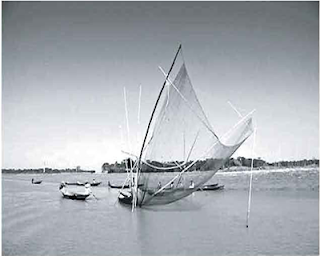1. Warm up activity:
□ Read the title of the article and look at the picture. Do not read the text yet. Guess what kind of information you are likely to get from the article.
In pairs, discuss whether the article may contain the following information-
□ Location and surrounding areas of Hakaluki Haor.
□ Kinds of fish available in Hakaluki Haor.
□ Kinds of migratory birds that visit the Haor in winter.
□ The economic importance of the Haor.
2. Now read the article and see how much of the above information you can find in it.
Hakaluki: A rich hub of biodiversity and livelihood
Bangladesh is blessed with huge inland open water resources. It has numerous river canals, beels, lakes, and vast areas of floodplains. Hakaluki haor is one of the major wetlands of Bangladesh. With a land area of 18,386 hectares, it supports a rich biodiversity and provides direct and indirect livelihood benefits to nearly 190,000 people. This haor was declared an Ecologically Critical Area in April 1999 by the government of Bangladesh.
Hakaluki is a complex ecosystem, containing more than 238 interconnecting beels and jalmahals. The most important beels are Chatla, Pinlarkona, Dulla, Sakua, Barajalla, Balijhuri, Lamba, Tekonia, Haorkhal, Tural, Baghalkuri and Chinaura.
Hakaluki Haor is bounded by the Kushiara river as well as a part of the Sonai Bardal river to the north, by the Fenchuganj-Kulaura railway to the west and to the south, and by the Kulanra-Beanibazar road to the east The haor falls under two administrative districts, Maulvibazar and Sylbet Some 190,000 people Kve in the area surrounding the haor.
Hakaluki Haor is an important source of fisheries resources for Bangladesh. Kalibaus, Boal, Rui, Ghagot, Pabda and Chapila are the main fish species found here. From the Kushiara there are frequmt upstream movement of fish towards the beels and tributaries of Hakalulri. The beels in Hakaluki haor provide winter shelter for the mother fisheries, In early monsoon these mother fisheries produce millions of fries for the entire downstream fishing communities. Floodplurns are also an important source of fisheries resources within the area. However, many of the beels have lost their capacity to provide shelter for mother fisheries because of sand deposits from upstream rivers and canals, use of complete dewatering technique for fishing and lack of aquatic plants to provide feed and shelter for parent fish.
The haor is a very important resting place for migratory waterfowls flying in from the north. The most interesting species is the Baiheaded Goose, which is now hardly seen in fresh water wetlands. Many other important species of waterfowls make the Haor their temporary home. Unfortunately, illegal poaching has been a threat to the waterfowl population in this vagt wetland. Hakaluki haor is known as a good grazing land in winter. People from villages around the Haor and also from distant areas send their herds for grazing. During this time, herders make temporary' shelters near the beels and graze their animals for a period of 4-5 months. The Haor had very dense swamp forests in the past, but deforestation and a lack of conservation practices have virtually destroyed this unique forest in the Last two decades.
Two small patches of swamp forests still exist in the area of which one is in Chatla beel and the other near the village of Kalikrishnapur. With the exception of these two swamp forest patches, the vegetation surrounding Hakaluki haor is unique. It includes both swamp forest as well as mixed evergreen rain forest. Thatching material is the most useful natural wetland product of the area. The haor system provides a wide range of economic and non-economic benefits to the local people as well as to the people of Bangladesh.
These include fish production, rice production, cattle and buffalo rearing, duck rearing, collection of reeds and grasses, and collection of aquatic and other plants. The haor system also protects the lower floodplains from flash floods occurring in the months of April-May, maintains the supply of fish in other lower water bodies and provides habitat for migratory and local waterfowls.
The unique haor system contributes to the beauty of the landscape both during the monsoon and the dry season. In monsoon, its unique scenic beauty makes it a huge natural bowl of water and in the dry season it becomes a vast green grassland with pockets of beels serving as resting places for migratory birds. This unique natural system can be a major attraction for tourists.
[Adapted from: http://www.doc.gov.bd/old/cwbmp/cwbmp pdi/final draft hakaluki cvaluation.pdf, Economic Evaluation of Hakaluki Haor : Department of Environment, Ministry of Environment and Forests, Government of Bangladesh]
3. Answer the following questions:
a. Why is Hakaluki Haor an important source of fisheries?
b. What are 'mother fisheries'? What do they do?
c. What bird species are seen in Hakaluki Haor in winter?
d. What economic benefits does the Haor provide to locals?
e. Describe the natural beauty of Hakaluki Haor.
4. Do you know any wetland (beel, jalmahal, haor etc.) in your area? Write a short article in ISO words about the wetland. Your article should contain some or all of the following points:
□ the name, location and area of the wetland.
□ the kinds of fishes available.
□ the kinds of vegetation that grow in and around.
□ benefits it provides.
□ its natural beauty.
5. Match the words in Column A with their meanings in Column B.
6. Find English equivalents of the following water-bodies aod give a brief description of each:
a. beel
b. haor
c. jalmahal
7. Give antonyms of the following words:
a. complex
b. numerous
c. major
d. downstream
e. mixed
f. distant
If you want to read the next lesson of this unit please click the link below:
Lesson 3: The Giant Panda









0 Comments:
Post a Comment